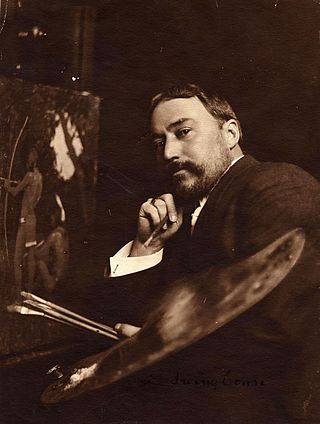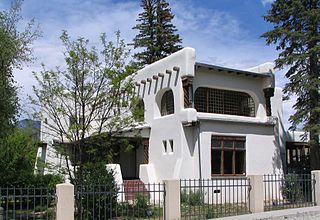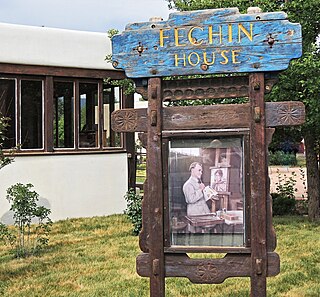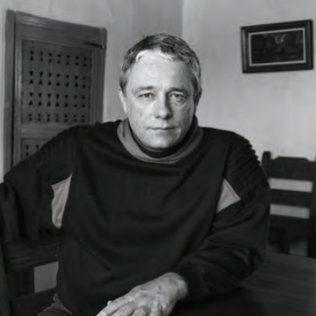
Taos is a town in Taos County in the north-central region of New Mexico in the Sangre de Cristo Mountains. Initially founded in 1615, it was intermittently occupied until its formal establishment in 1795 by Nuevo México Governor Fernando Chacón to act as fortified plaza and trading outpost for the neighboring Native American Taos Pueblo and Hispano communities, including Ranchos de Taos, Cañon, Taos Canyon, Ranchitos, El Prado, and Arroyo Seco. The town was incorporated in 1934. As of the 2010 census, its population was 5,716.

The Taos art colony was an art colony founded in Taos, New Mexico, by artists attracted by the culture of the Taos Pueblo and northern New Mexico. The history of Hispanic craftsmanship in furniture, tin work, and other mediums also played a role in creating a multicultural tradition of art in the area.

Ernest Leonard Blumenschein was an American artist and founding member of the Taos Society of Artists. He is noted for paintings of Native Americans, New Mexico and the American Southwest.

Eanger Irving Couse was an American artist and a founding member and first president of the Taos Society of Artists. Born and reared in Saginaw, Michigan, he went to New York City and Paris to study art. While spending summers in Taos, New Mexico, he began to make the paintings of Native Americans, New Mexico, and the American Southwest for which he is best known. He later settled full time in Taos.

Mabel Evans Dodge Sterne Luhan was a wealthy American patron of the arts, who was particularly associated with the Taos art colony.

Nicolai Fechin was a Russian-American painter known for his portraits and works featuring Native Americans. After graduating with the highest marks from the Imperial Academy of Arts and traveling in Europe under a Prix de Rome, he returned to his native Kazan, where he taught and painted. He exhibited his first work in the United States in 1910 in an international exhibition in Pittsburgh, Pennsylvania. After immigrating with his family to New York in 1923 and working there for a few years, Fechin developed tuberculosis and moved West for a drier climate. He and his family settled in Taos, New Mexico, where he became fascinated by Native Americans and the landscape. The adobe house which he renovated in Taos is listed on the National Register of Historic Places and is used as the Taos Art Museum. After leaving Taos in 1933, Fechin eventually settled in southern California.
William Victor Higgins was an American painter and teacher, born in Shelbyville, Indiana. At the age of fifteen, he moved to Chicago, where he studied at the Art Institute in Chicago and at the Chicago Academy of Fine Arts. In Paris he was a pupil of Robert Henri, René Menard and Lucien Simon, and when he was in Munich he studied with Hans von Hayek. He was an associate of the National Academy of Design. Higgins moved to Taos, New Mexico in 1913 and joined the Taos Society of Artists in 1917. In 1923 he was on the founding board of the Harwood Foundation with Elizabeth (Lucy) Harwood and Bert Phillips.

Herron–Morton Place is a historic district in Indianapolis, Indiana, United States. The boundaries of the neighborhood are East 16th Street on the south, East 22nd Street on the north, North Pennsylvania Street on the west, and Central Avenue on the east.

The Eanger Irving Couse House and Studio—Joseph Henry Sharp Studios, also known as the Couse/Sharp Historic Site, is a property on the U.S. National Register of Historic Places. It includes the home and art studio of E. Irving Couse (1866–1936) and two studio buildings owned by Joseph Henry Sharp (1859-1953), both founding members of the Taos Society of Artists. It was added to the NRHP on September 28, 2005.

The Nicolai Fechin House in Taos, New Mexico, is the historic home of the Russian artist Nicolai Fechin, his wife Alexandra and daughter Eya. After purchasing the house in 1928, he spent several years enlarging and modifying the two-story adobe structure, for instance, enlarging the porch and adding and widening windows to take advantage of the views. He carved many of the fittings of the house and its furniture, using typical Russian design elements such as "triptych windows and intricately carved doors." The whole reflects a modernist sensibility combined with Russian, Native American and Spanish traditions.

The Harwood Museum of Art is located in Taos, New Mexico. Founded in 1923 by the Harwood Foundation, it is the second oldest art museum in New Mexico. Its collections include a wide range of Hispanic works and visual arts from the Taos Society of Artists, Taos Moderns, and contemporary artists. In 1935 the museum was purchased by the University of New Mexico. Since then the property has been expanded to include an auditorium, library and additional exhibition space.

The Taos Art Museum is an art museum located in Taos, New Mexico in the Nicolai Fechin House. This was the home of Russian artist Nicolai Fechin, his wife Alexandra, and daughter Eya. The museum's primary aims are to improve awareness of the works and patronage of Taos artists and to nurture local artistic development. Many of the works of the Taos Society of Artists are held by museums outside of New Mexico, leading them to work to "Bring Taos art back to Taos."

The Governor Bent House is the historic home of Governor Charles Bent who served as the first United States territorial governor of New Mexico.

Taos Downtown Historic District is a historic district in Taos, New Mexico. Taos "played a major role in the development of New Mexico, under Spanish, Mexican, and American governments." It is a key historical feature of the Enchanted Circle Scenic Byway of northern New Mexico.
Robert M. Ellis was an American artist. His professional career spanned six decades as an artist, educator, and museum director, including eight years as Curator of Education at the Pasadena Art Museum in California, twenty-three years on the art faculty of University of New Mexico, in Albuquerque, and ten years as director of UNM's Harwood Museum of Art in Taos, New Mexico. His work is in numerous museum collections, including the Albuquerque Museum of Art and History, New Mexico Museum of Art in Santa Fe, and Roswell Museum and Art Center. Apart from his distinguished career as a painter, Ellis left an indelible mark on the art world in both southern California and northern New Mexico.

Harold Joe Waldrum was an American artist whose abstract works depict color studies especially of the old adobe churches of Northern New Mexico. He also used a Polaroid SX-70 camera to photograph many of the churches, initially as part of the process in creating his paintings. However, this collection of thousands of photographs became a body of work in and of itself and was exhibited at several galleries and museums.
Rebecca Salsbury James (1891–1968) was a self-taught American painter, born in London, England of American parents who were traveling with the Buffalo Bill Wild West Show. She settled in New York City, where she married photographer Paul Strand. Following her divorce from Strand, James moved to Taos, New Mexico where she fell in with a group that included Mabel Dodge Luhan, Dorothy Brett, and Frieda Lawrence. In 1937 she married William James, a businessman from Denver, Colorado who was then operating the Kit Carson Trading Company in Taos. She remained in Taos until her death in 1968.

Beatrice Mandelman, known as Bea, was an American abstract artist associated with the group known as the Taos Moderns. She was born in Newark, New Jersey to Anna Lisker Mandelman and Louis Mandelman, Jewish immigrants who imbued their children with their social justice values and love of the arts. After studying art in New York City and being employed by the Works Progress Administration Federal Arts Project (WPA-FAP), Mandelman arrived in Taos, New Mexico, with her artist husband Louis Leon Ribak in 1944 at the age of 32. Mandelman's oeuvre consisted mainly of paintings, prints, and collages. Much of her work was highly abstract, including her representational pieces such as cityscapes, landscapes, and still lifes. Through the 1940s, her paintings feature richly textured surfaces and a subtly modulated, often subdued color palette. New Mexico landscape and culture had a profound influence on Mandelman's style, influencing it towards a brighter palette, more geometric forms, flatter surfaces, and more crisply defined forms. One critic wrote that the "twin poles" of her work were Cubism and Expressionism. Her work is included in many major public collections, including large holdings at the University of New Mexico Art Museum and Harwood Museum of Art.
Robert Ray was an American artist, active in the middle to late twentieth century.
Juanita Jaramillo Lavadie is a contemporary weaver, textile scholar and muralist based in New Mexico. Her art is centered on the acequia system in Taos County, Northern, New Mexico and is influenced by traditional Hispano and Indigenous cultures. Her work primarily focuses on water rights in Taos County.















